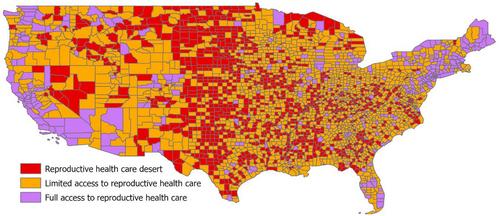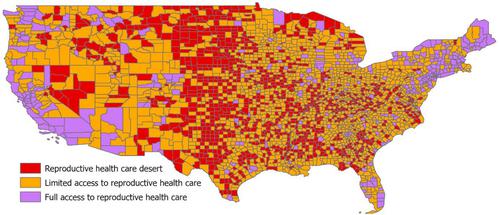Health care use and health consequences of geographic lack of access to abortion and maternity care
Abstract
Background
Recent years have brought substantial declines in geographic access to abortion facilities and maternity care across the US. The purpose of this study was to identify the reproductive health consequences of living in a county without access to comprehensive reproductive health care services.
Methods
We analyzed National Center for Health Statistics data on all live births occurring in the US in 2020. We used data on locations of abortion facilities and availability of maternity care in order to classify counties by level of access to comprehensive reproductive health care services and defined comprehensive reproductive health care deserts as counties that did not have an abortion facility in the county or in any neighboring county and did not have any maternity care practitioners. We fit modified Poisson regression models with generalized estimating equations to estimate the degree to which living in a comprehensive reproductive health care desert was associated with receipt of timely and adequate prenatal care and risk of preterm birth, controlling for individual-level and county-level characteristics.
Results
In 2020, one third of counties in the US were comprehensive reproductive health care deserts (n = 1082), and 136,272 births occurred in these counties. In adjusted models, there was no difference in prenatal health care use (timeliness or adequacy of care) between persons in comprehensive reproductive health care deserts and those with full access to care, but the risk of preterm birth was significantly elevated (aRR =1.09, 95% CI = 1.06, 1.13).
Conclusions
Lack of access to comprehensive reproductive health care services may increase the incidence of preterm birth.



 求助内容:
求助内容: 应助结果提醒方式:
应助结果提醒方式:


